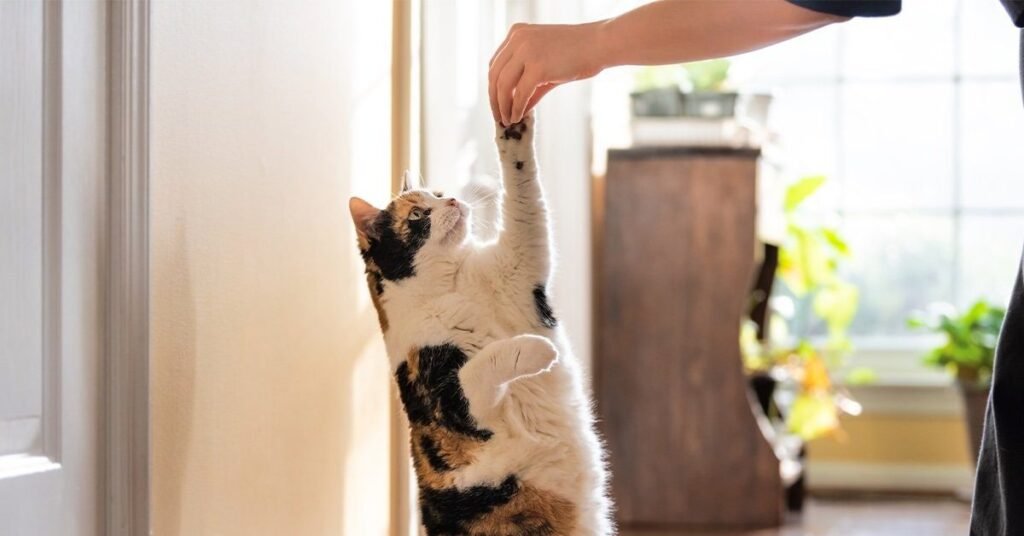Have you ever wondered why your cat acts the way they do? As a long-time cat owner, I’ve asked myself this question more times than I can count. Living with a cat can sometimes feel like sharing your home with an unpredictable roommate. One moment they’re purring affectionately in your lap, and the next they’re perched atop the tallest bookshelf, glaring down at you like a furry monarch. Understanding the mysterious world of cat behavior can be a challenge, but with a bit of patience—and some practical training tips—we can turn these quirks into a harmonious cohabitation.

This image is property of www.thesprucepets.com.
Understanding Feline Behavior
Before diving into the nitty-gritty of training, it’s essential to get a grasp on why cats behave the way they do. Cats are not the same as dogs; they come with their own set of rules and motivations. Understanding these can be the first step towards a more peaceful household.
Why Do Cats Do That?
Cats display certain behaviors that often leave us bewildered. Scratching the furniture, knocking things off shelves, and nocturnal shenanigans are just a few examples. Unlike their canine counterparts who have co-evolved with humans for specific purposes, cats remain a bit more wild at heart. This wildness manifests in behaviors linked to their instincts. Scratching, for instance, helps keep their claws sharp, mark territory, and stretch their muscles. It’s not spiteful; it’s instinctual.
Cat Communication: The Basics
Cats, with their quiet elegance, are master communicators in their own right. They employ a mix of vocalizations, body language, and scent markings to express themselves. The purr, meow, and hiss each hold valuable clues into a cat’s emotional state or needs. When Miss Whiskers wraps herself around your legs and lets out a soft purr, she’s not just saying hello—she’s expressing contentment. The more you observe your cat’s habits and cues, the better you’ll be at responding to her needs effectively.
Training Your Cat: Myth or Reality?
Many people believe that cats are untrainable, stubborn creatures who march to the beat of their own drum. While I’ll admit cats do tend to prioritize their own agendas, this doesn’t mean they can’t learn some house manners. With the right techniques and a little bit of consistency, you’d be surprised how much a cat can learn.
Debunking the Myth
The myth of the untrainable cat likely stems from comparisons to the more eager-to-please nature of dogs. However, it’s essential to understand that cats learn and respond to training differently. Training a cat is less about dominance and more about motivating them through positive reinforcement.
Patience: A Vital Ingredient
Training cats requires a generous helping of patience. Cats may not respond immediately, and repetition is key. Unlike dogs, they may appear disinterested or aloof, but this does not mean they’re not paying attention. Keep sessions short and always end on a positive note, as cats thrive on positive experiences.
Setting the Stage for Training
Before jumping into specific training exercises, laying the groundwork is crucial. Ensuring that your cat’s environment is conducive to learning can set you both up for success.
Creating a Positive Environment
Cats need a safe, stress-free environment to thrive. This includes having access to their favorite spots, like a cozy hideaway or a perch to survey their kingdom. A good scratching post is a must, especially if you want to save your expensive furniture from becoming your cat’s next scratching casualty.
Tools of the Trade
Consider investing in some basic training tools. Treats are an obvious choice. Find ones your cat really goes wild for and reserve them for training sessions to keep them special. A clicker, although not universally loved by all cats, can be an effective tool for signaling a job well done. Also, considering your cat’s health and pleasure, a selection of toys can be used not only for entertainment but as distractions and training aids.
Common Training Techniques
Now that we have the basics sorted, it’s time to roll up our sleeves and get to the actual training. While it’s crucial to tailor your methods to your cat’s personality, here’s a glimpse into some basic training techniques that can make all the difference.
Positive Reinforcement
This technique revolves around rewarding your cat for good behavior, thus increasing the likelihood of them repeating it. Let’s say you’re trying to teach your cat to scratch the post instead of your couch. Whenever they choose the post, reward them with a treat or some petting, reinforcing that choice as a positive one.
Clicker Training
Clicker training is another fantastic method, especially for teaching tricks or behaviors that require more precision. The sound of the click marks the exact moment your cat does what you want, followed by a reward. With consistency, your cat will associate the click with a reward and understand exactly what you’re asking of them.
Redirecting Negative Behavior
Not all behavior will be as easy as a simple redirect. Cats, being the curious creatures they are, might be creating chaos out of pure boredom. Sometimes it’s about understanding the underlying need—why is Miss Whiskers incessantly scratching that specific spot? Perhaps that’s where the sun hits perfectly, or she found comfort there. Introducing alternatives, like scratching posts, or switching out toys regularly, can keep things exciting and redirect unwanted behavior.

This image is property of Amazon.com.
Addressing Specific Unwanted Behaviors
While some antics are endearing, others can challenge our patience. Let’s tackle some of the more common cat misbehaviors and how to address them constructively.
Scratching Furniture
As previously mentioned, scratching is instinctual. However, we can gently steer this habit away from our favorite couch. Introducing multiple scratching posts and pads around the house can help. Additionally, you can make unwanted scratching surfaces unattractive by using deterrents like double-sided tape or specialized sprays.
Litter Box Issues
A common cause of frustration among cat owners is when their furry companion refuses to use the litter box. First and foremost, ensure that the box is regularly cleaned; cats are fastidious creatures, and a smelly litter box is an instant no-go for them. It’s also vital to consider the box’s location—privacy is essential. If problems persist, it could be a medical issue, and a vet visit is recommended.
Overcoming Fear and Aggression
Fear and aggression can often be tied to past trauma or a lack of socialization. It’s important to approach these issues gently. Encourage gradual exposure to positive experiences, always paired with rewards. Never force the situation; give your cat space to come to you. Over time, with patience, trust is built, and the aggressive or fearful behavior should lessen.
Encouraging Good Behavior
Now that we’ve covered the “don’ts,” what about the “dos”? Encouraging good behavior is just as crucial as curbing the unwanted actions.
Playtime is Essential
Play isn’t just about burning off energy, though it’s undoubtedly helpful in preventing nighttime zoomies. Interactive play strengthens the bond between you and your cat and keeps them mentally stimulated. Toys that mimic the hunt, like wands or laser pointers, can satisfy this primal instinct.
Consistent Feeding Times
Having a routine, especially around feeding, provides a sense of security. You’ll often find that a cat accustomed to mealtime will exhibit fewer random food-related tantrums. They appreciate predictability, and it may just save you from being woken up at 5 AM for breakfast.
Affection on Their Terms
Cats are famously prickly about receiving affection, which seems limited only by their whims. As much as we want to shower them with love, it’s often best to let them lead. When they do decide it’s time for a snuggle, enjoy it.

This image is property of www.catschool.co.
Tailoring Training to Personality
Just like humans, every cat is unique. One size does not fit all when it comes to training, and understanding your cat’s personality can provide a roadmap for a successful approach.
The Shy Cat
For shy or anxious cats, training should be a quiet, calming experience. Slow introductions, a gentle voice, and patience make all the difference. They won’t respond well to loud noises or abrupt movements, so keep it gentle and let them come to you.
The Bold Explorer
This confident kitty might seem untrainable due to their adventurous antics. Harness their curiosity by creating a stimulating environment full of new and exciting challenges. Channels that energy into training can be a rewarding mutual experience.
The Social Butterfly
These cats usually love being the center of attention, making them easier to train with the right incentives. They often thrive on new tricks or tasks, as long as they receive the attention and praise they so greatly desire.
Troubleshooting Training Challenges
Despite our best efforts, sometimes things don’t go as planned. Training challenges are part of the process, and having a strategy to overcome them is essential.
Consistency Issues
Do you ever find yourself hot and cold about enforcing house rules? Cats can pick up on inconsistency, which can lead to confusion. Ensure everyone in the household is on the same page about training rules and routines.
Lack of Motivation
Not every kitty will be motivated by food or affection. Discover what truly moves your cat—sometimes it’s a particular toy or activity. Additionally, don’t shy away from modifying your training plan if the initial approach doesn’t yield results.

This image is property of www.pumpkin.care.
Conclusion: Living in Harmony
It might seem like a lot to take in, but patience and love can work wonders in bridging the communication gap between you and your feline friend. Consider these tips as guidelines rather than strict rules. Each cat is different, and it’s all about what works best for both you and your beloved pet.
Living with cats is an adventure, filled with moments of mutual adoration, exasperation, and lots of learning. With understanding, training, and an open mind, we can better enjoy the quirky company of our companions. After all, aren’t those unique feline antics part of why we love cats so much?





